The silhouette of a Kalbelia dancer swirling to the tune of the snake charmer’s flute on the backdrop of an ochre landscape blushing under the setting sun — an image enticing enough to lure you to Rajasthan

Rajasthan
Best time to visit: Oct-June
You need: 5 days
I have already spent four days roaming the narrow, serpentine lanes and bylanes of Jaisalmer, admiring the intricately carved havelis, sampling various versions of apple pies and falafels and steering clear of conversations related to maachher jhol and muffler. The sprawling sandstone town hemmed by the shimmering Thar Desert is regarded as a pilgrimage site by the Bongs ever since Satyajit Ray wrote his famous detective novel, Sonar Kella (Golden Fortress) way back in 1971.
ADVERTISEMENT
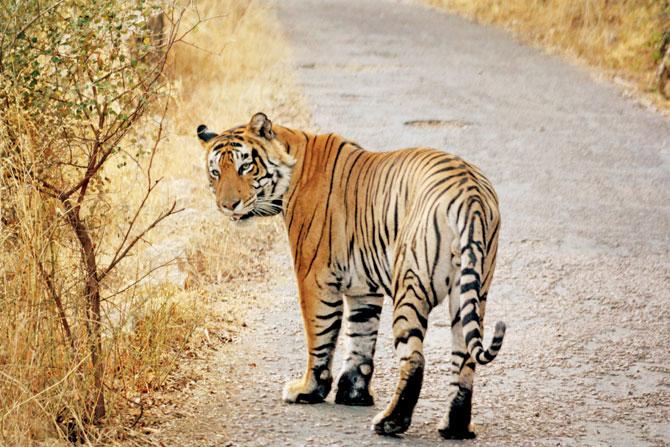
A male tiger
But one evening, I decide to take a break from that collective nostalgia and explore a few nearby places. Being a bit
old-school (read technologically challenged), I usually travel with a map and a compass. My map leads me to the Desert National Park. But to go there, one needs permission from the Forest Department. Once I reach the small office, the Forest Officer sounds almost ecstatic at the prospect of getting a tourist to visit his labour of love. However, his excitement fizzles out on hearing that I am travelling alone. But after the initial dissapointment, he proceeds to not only sign the document but also offers to be my guide the next morning. Ah! I have always depended on the kindness of strangers.
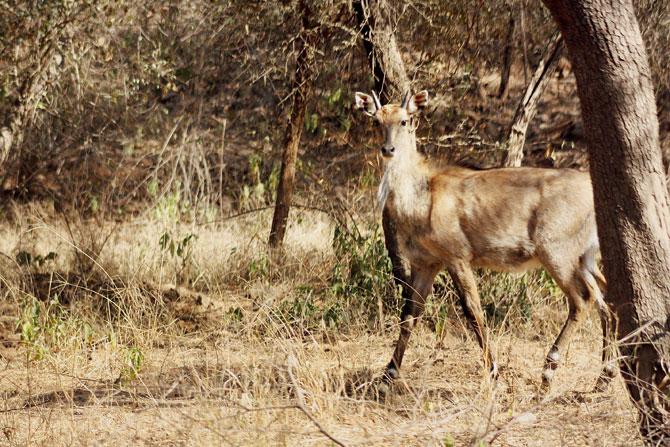
Antelope
It’s a bird?
The next morning, we go on a long drive - where we encounter a small sandstorm and have the quintessential jeep-getting-stuck-in-the-sand moment -- which takes us to the gate of the park. I have been to many national parks and the toss-up is usually between a canter, a jeep or maybe the occasional elephant. But my royal ride here is a camel cart. I hop on to it and take a bumpy ride through a rocky desert landscape of shrubs and thorn bushes and occasional patches of greenery. Just then, the cart puller points to my left: “Madam Bustard!” he says excitedly. What? Did he just call me a bastard? How dare... Suddenly, I remember that I am promised a sighting of the critically endangered Great Indian Bustard. “Madam, aap mere saath aao, paas se dekhenge (Madam, come with me, we will take a closer look),” he said. A walk through a national park full of bustards is not really my idea of an adventure. Perhaps these Bustards are really friendly, innocent donkeys, I convince myself as I slowly follow him. All I can see is a solemn-looking bird which closely resembles an ostrich. As it readies itself to fly, he whispers, “Madam, ab toh udnewala hay (now he is going to fly).” That is a Bustard? A bird? Apparently, I am one of those few lucky souls to have spotted one.
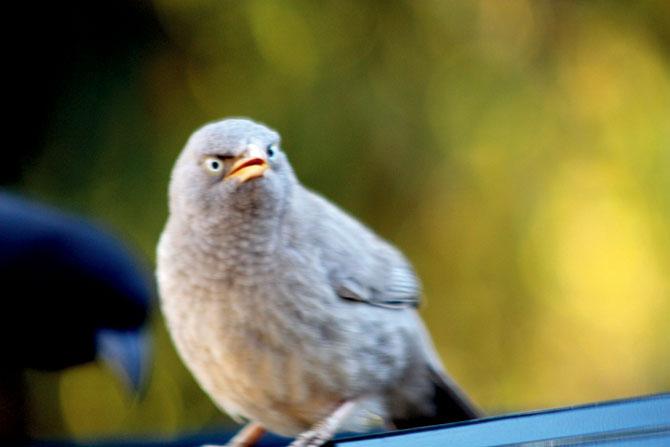
Jungle babbler
A cacophony of cries
After a week in Jaisalmer, my parched eyes are in desperate need of some greenery. I head to Keoladeo National Park in Bharatpur. I am no ornithologist and my bird-spotting skills are put to test just a few days back. Also, much has been written about how the heydays of this UNESCO World Heritage Site are now over due to acute scarcity of water. But, I am lured by its name -- it has a nice ring to it. And if not anything, I will indulge in some ‘Waldeinsamkeit’!
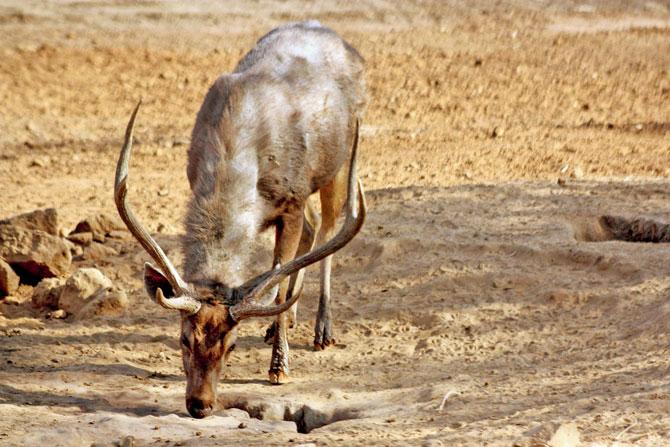
Barasingha
I reach the gates of the bird sanctuary at almost 4 pm and I rush to get the entry ticket. “Madam, rickshaw or bicycle?” asks the man at the counter. Given my penchant for bicycle-related mishaps (32 stitches. Need I say more?) and the fact that I just have about two hours to explore the forest, I opt for a rickshaw and hire a forest guide. A few miles into the journey, he insists we go a bit off the beaten track and explore the area by foot. As we walk through the forest, I am surprised to find the sanctuary throb with life. Its avian population, apart from the more common parakeets, peacocks, owls and kingfishers, includes Pin Tailed Ducks, Purple Herons, Grey Hornbills, Painted Storks, Oriental Darter and the Jungle Babbler which, I learn, is fondly called Seven Sisters’ as they are usually found in a flock of seven.
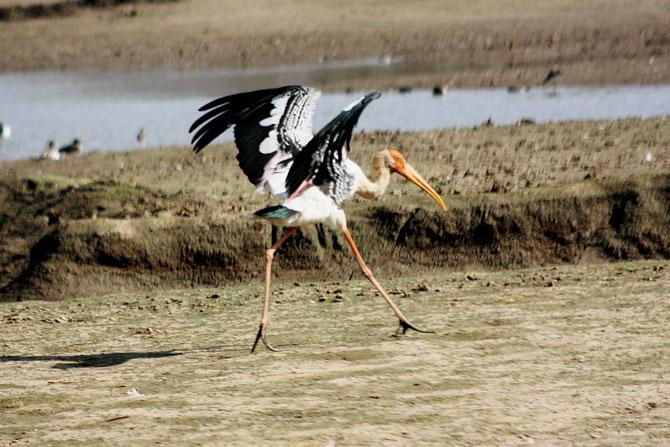 Painted stork
Painted stork
It’s nearly sunset and I catch the birds feeding the young and listen in to the males’ mating calls. For a person whose experience in birdwatching is limited to gazing at crows and pigeons on lampposts, it is an overwhelming sight.
His majesty’s visit
Next, I head to Sariska Tiger Reserve, which is an hour-long bus ride from Alwar. In 2005, the reserve had no tigers left due to excessive poaching and in 2008, a project was initiated to reintroduce tigers into Sariska from the nearby Ranthambore National Park. However, spread across an area of around 866 km, it is huge compared to its more popular counterpart and given the low density of tigers, it hardly makes it to most nature lovers’ list.
This time in the jeep, apart from the driver, I am accompanied by a forest guard, who speaks little but smiles a lot. Ours is the only vehicle on the route apart from the occasional patrol car. The forest guard decides to check the control room to track tigers’ movements in the vicinity. After the reintroduction of tigers, the forest department has become extra-cautious and now, all tigers in the area are radio-collared. We catch a signal, albeit a frail one, from the top of one of the hills. Our guard has a gut feeling that the tiger might come down in another half an hour and cross the road. So we decide to give it a shot and return to the spot. We wait. There is an eerie calm and we can almost count each other’s heartbeats. The car is parked in the middle of a road in full view and the tiger could come from any side. With only 45 minutes to spare before all vehicles are required to leave the park, we are acutely aware of the ticking clock. Suddenly, my heart skips a beat. There he is, walking majestically down the road. Even the forest guard can’t believe his luck. “This is the first time I am seeing this one! It is the ST-6 -- one of the two male tigers!” he whispers. The driver stealthily follows the tiger while I, still shaking with excitement, click furiously to capture His Highness. He turns back and looks amused on spotting my camera. “Ah, these silly humans,” I can almost hear him think. For the next 15 minutes we follow him, until he gets bored with all the attention and aborts his plans for an evening walk. As he disappears into the jungle, I pinch myself. Did I just see a tiger?
Fact File
Getting there:
To get to the Desert National Park in Jaisalmer, the nearest airport is Jodhpur. If travelling by road from Delhi, Jaisalmer is 882 kms away from the metro. You have to go a further 40 kms from Jaisalmer to get to the Desert National Park. The best time to visit the Park is from October to March.
To get to the Bharatpur Bird Sanctuary, the nearest airport is Jaipur. By road from Delhi, Jaipur and Alwar, you have to travel 184 km, 176 km and 117 km respectively to get to the Sanctuary. The best time to visit is from November to March.
To get to the Sariska Tiger Reserve, the nearest airport is Jaipur. If coming from Delhi, Jaipur or Alwar, you will have to cover 200 km, 107 km or 35 km respectively. Although the Reserve is open from October to June, the best time to spot tigers is from April to June
Where to Stay: RTDC has resorts in Alwar, Jaipur, Jaisalmer and Bharatpur
 Subscribe today by clicking the link and stay updated with the latest news!" Click here!
Subscribe today by clicking the link and stay updated with the latest news!" Click here!







